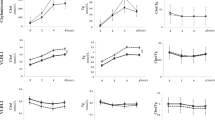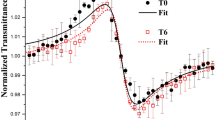Abstract
Background: In a recent pilot study, the intake of elderberry juice resulted in a significant decrease in serum cholesterol concentrations and an increase in low-density lipoprotein (LDL) stability. This study was designed to verify the preliminary results.
Objective: We investigated the impact of elderberry juice on cholesterol and triglyceride concentrations as well as antioxidant status in a cohort of young volunteers.
Design: Study A: The randomized, placebo-controlled trial for studying the effect of anthocyanes on lipid and antioxidant status, 34 subjects took capsules with 400 mg spray-dried powder containing 10% anthocyanes t.i.d. equivalent to 5 ml elderberry juice for 2 weeks. A subgroup of 14 subjects continued for an additional week to test for resistance to oxidation of LDL. Study B: To investigate the short-term effects on serum lipid concentrations, six subjects took a single dose of 50 ml of elderberry juice (equivalent to 10 capsules) along with a high-fat breakfast.
Results: In the placebo-controlled study, there was only a small, statistically not significant change in cholesterol concentrations in the elderberry group (from 199 to 190 mg/dl) compared to the placebo group (from 192 to 196 mg/dl). The resistance to copper-induced oxidation of LDL did not change within 3 weeks. In the single-dose experiment increases in postprandial triglyceride concentrations were not significantly different when the six subjects were investigated with and without elderberry juice.
Conclusions: Elderberry spray-dried extract at a low dose exerts a minor effect on serum lipids and antioxidative capacity. Higher, but nutritionally relevant doses might significantly reduce postprandial serum lipids.
Sponsorship: This study was supported by the Austrian Industrial Research Fund (FFF, Project Nr. 802230) and the Steirische Beerenfrost GmbH.
This is a preview of subscription content, access via your institution
Access options
Subscribe to this journal
Receive 12 print issues and online access
$259.00 per year
only $21.58 per issue
Buy this article
- Purchase on Springer Link
- Instant access to full article PDF
Prices may be subject to local taxes which are calculated during checkout



Similar content being viewed by others
References
Abuja PM, Murkovic M & Pfannhauser W (1998): Antioxidant and prooxidant activities of elderberry (Sambucus nigra) extract in low-density lipoprotein oxidation. J. Agric. Food. Chem. 46, 4091–4096.
Bergmann AM, Ramos P, Esterbauer H & Winklhofer-Roob BM (1997): RRR-α-tocopherol can be substituted for by trolox in determination of kinetic parameters of LDL oxidizability by copper. J. Lipid Res. 38, 2580–2588.
Castelli WP, Garrison RJ, Wilson PQWF, Abbott RT, Kalousdian S & Kannal WB (1986): Incidence of CHD and lipoprotein cholesterol levels: the Framingham Study. JAMA 256, 2853–2858.
Dieber-Rotheneder M, Puhl H, Waeg G, Striegl G & Esterbauer H (1991): Effect of oral supplementation with D-alpha-tocopherol on the vitamin E content of human low density lipoproteins and resistance to oxidation. J. Lipid. Res. 32, 1325–1332.
Ebenbichler CF, Kirchmair R, Egger C & Patsch JR (1995): Postprandial state and atherosclerosis. Curr. Opinion. Lipidol. 6, 286–290.
Esterbauer H, Schmidt R & Hayn M (1997): Relationship among oxidation of low-density lipoprotein, antioxidant protection, and atherosclerosis. Adv. Pharmacol. 38, 425–456.
Esteve JM, Farré R, Frigola A & Garcia-Cantabella F (1997): Determination of ascorbic and dehydroascorbic acids in blood plasma and serum by liquid chromatography. J. Chromatogr. B. 688, 345–349.
Halliwell B (1993): The role of oxygen radicals in human disease, with particular reference to the vascular system. Haemostasis 23, 151–172.
Heinonen M, Meyer AS & Frankel EN (1998): Antioxidant activity of berry phenolics on human low-density lipoprotein and liposome oxidation. J. Agric. Food. Chem. 46, 4107–4112.
Hertog MGL, Feskens EJM, Hollman PCH, Katan MB & Kromhout D (1993): Dietary antioxidant flavonoids and risk of coronary heart disease: the Zutphen eldery study. Lancet 342, 1007–1011.
Hertog MGL, Kromhout D, Aravanis C, Blackburn H, Buzina R, Fidanza F, Giampaoli S, Jansen A, Menotti A, Nedeljkovic S, Pekkarinen M, Simic BS, Toshima H, Feskens EJM, Hollman PCH & Katan MB (1995): Flavonoid intake and long-term risk of coronary heart disease and cancer in the seven countries study. Arch. Int. Med. 155, 381–386.
Hollman PCH, Hertog MGL & Kata MB (1996): Analysis of health effects of flavonoids. Food Chem. 57, 43–46.
Murkovic M, Adam U & Pfannhauser W (2000b): Analysis of anthocyane glycosides in human serum. Fresenius J. Anal. Chem. 366, 379–381.
Murkovic M, Toplak H, Adam U & Pfannhauser W (2000a): Analysis of anthocyanins in plasma for determination of their bioavailability. J. Food. Comp. Anal. 13, 291–296.
Natella F, Belelli F, Gentili V, Ursini F & Scaccini C (2002): Grape seed proanthocyanidins prevent plasma postprandial oxidative stress in humans. J. Agric. Food. Chem. 50, 7720–7725.
Piironen V, Lindsay DG, Miettinen TA, Toivo J & Lampi AM (2000): Plant sterols: biosynthesis, biological function and their importance to human nutrition. J. Sci. Food. Agric. 80, 939–966.
Ramos P, Gieseg SP, Schuster B & Esterbauer H (1995): Effect of temperature and phase transition on oxidation resistance of low-density lipoprotein. J. Lipid. Res. 36, 2113–2129.
Renaud S & Lorgeril M (1992): Wine, alcohol, platelets and the French paradox for coronary heart disease. Lancet 339, 1523–1526.
Rice-Evans K (1999): Screening of phenolics and flavonoids for antioxidant activity. In Antioxidant Food Supplements in Human Health, eds L Packer, M Hiramatsu & T Yoshikawa pp 239–253. Academic Press. London, UK.
Satué-Garcia T, Heinonen M & Frankel EN (1997): Anthocyanins as antioxidants on human LDL and lecithin-liposome systems. J. Agric. Food. Chem. 45, 3362–3367.
Toplak H, Sagmeister E & Wascher TC (1994): Cardiovascular risk factors in obesity. The effect of weight reduction on platelet size in overweight patients. Int. J. Obes. Relat. Metab. Disord. 18, 355–356.
Ursini F & Sevanian A (2002): Postpranidal oxidative stress. Biol. Chem. 383, 599–605.
Vuilleumier JP, Keller HE, Gysel D & Hunziker F (1983): Clinical chemical methods for the routine assessment of the vitamin status in human populations. Part I: the fat-soluble vitamins A and E, and beta-carotene. Int. J. Nutr. Res. 53, 265–272.
Acknowledgements
We thank Andrea Hillebrand for excellent technical assistance.
Author information
Authors and Affiliations
Contributions
Guarantor: M Murkovic
Contributors: M Murkovic, B Winkelhofer-Roob, P Abuja, H Toplak and A Bergmann conceived and designed the study, prepared the manuscript and were responsible for method development and data evaluation. A Zirngast and U Adam performed the analyses and helped to prepare the report. The sponsors of the study had no role in the study design, data collection, data analysis, data interpretation or writing of the report.
Corresponding author
Rights and permissions
About this article
Cite this article
Murkovic, M., Abuja, P., Bergmann, A. et al. Effects of elderberry juice on fasting and postprandial serum lipids and low-density lipoprotein oxidation in healthy volunteers: a randomized, double-blind, placebo-controlled study. Eur J Clin Nutr 58, 244–249 (2004). https://doi.org/10.1038/sj.ejcn.1601773
Received:
Revised:
Accepted:
Published:
Issue Date:
DOI: https://doi.org/10.1038/sj.ejcn.1601773
Keywords
This article is cited by
-
How effective are anthocyanins on healthy modification of cardiometabolic risk factors: a systematic review and meta-analysis
Diabetology & Metabolic Syndrome (2023)
-
The effect of 8 plant extracts and combinations on post-prandial blood glucose and insulin responses in healthy adults: a randomized controlled trial
Nutrition & Metabolism (2020)
-
Effects of Berries Consumption on Cardiovascular Risk Factors: A Meta-analysis with Trial Sequential Analysis of Randomized Controlled Trials
Scientific Reports (2016)
-
The effects of Sambucus nigra polyphenols on oxidative stress and metabolic disorders in experimental diabetes mellitus
Journal of Physiology and Biochemistry (2009)
-
Selection of elderberry (Sambucus nigra L.) genotypes best suited for the preparation of elderflower extracts rich in flavonoids and phenolic acids
European Food Research and Technology (2008)



